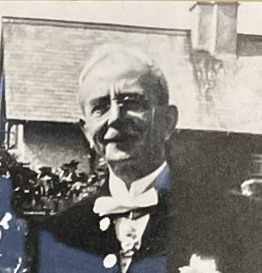
2022 marks several anniversaries in Sherrington’s life. This display commemorates the 90th anniversary (1932) of receiving the Nobel Prize for physiology and the 70th anniversary of his death in 1952. The exhibit features a replica of his Nobel Prize and the top hat he wore to the ceremony. The display includes a chronology of his achievements and a sample from his wide range of writing.
Sir Charles Scott Sherrington
While Sherrington wore many hats, including histologist, bacteriologist and a pathologist, he is best known today for his work in neurology and neurophysiology.
In Sherrington’s time, it was believed that reflexes occurred as an isolated activity within a reflex arc. The work of Sherrington and his co-researcher Edgar Adrian, abolished the then-accepted notion of Reticular Theory, which stated that the entire nervous system functions as a single interlinking network. Instead they established that “reflexes require integrated activation and demonstrated reciprocal innervation of muscles” known today as “Sherrington’s Law” or the principle of reciprocal innervation. Sherrington and Adrian won the 1931 Nobel Prize for Physiology for this discovery.
Sherrington notably introduced the term “synapse” in 1897 to describe the point of contact between two nerve cells. He also coined the word proprioception to describe the sensory information sent by muscle receptors.
His work shaped our modern understanding of how our reflexes, nerves and brain function and changed the study of neuroscience entirely.
Timeline
1857 27 November, born in London.
1871-76 Graduated Ipswich Grammar School
1876 Entered St. Thomas’s Hospital, London.
1879-83 Gonville and Caius College, Cambridge.
1884 Returned to St. Thomas’s
1885 Obtained M.R.C.S. and M.B. Went to Spain with C.S. Roy and J.J. Graham Brown to investigate supposed vaccine for an outbreak of cholera
1885-87 Studied under Rudolf Virchow and Robert Koch in Berlin, and F. Goltz in Strasbourg.
1887 Elected Fellow of Gonville and Caius College and Lecturer in Systematic Physiology and St. Thomas’s.
1893 Elected Fellow of the Royal Society of London.
1906 “The Integrative Action of the Nervous System” (Silliman LEctures, Yale University, 1904)
1913-36 Waynflete Professor of Physiology at Oxford and Fellow Magdalen College, Oxford.
1919 “Mammalian Physiology: a course of practical exercises;” illustrated by his students
1920-25 President of the Royal Society of London
1924 Awarded the Order of Merit
1932 Awarded the Nobel Prize for Physiology with Edgar D. Adrian.
1941 “Man on his Nature” (The Gifford Lectures, University of Edinburge, 1937-38
1946 The Endeavour of Jean Fernel
1952 4 March, died at Easterbourne, England at 95 years old
List of Items
- Nobel Prize Replica
- Sir Sherrington won his Nobel Prize in Physiology in 1932. This is a replica of the award.
- Sir Sherrington’s Top Hat
- Sir Sherrington’s top hat worn at the Nobel Prize ceremony
- Sherrington portrait
- Charles Scott Sherrington OM, GBE, FRS, MD
- 1857-1952
- Portrait by R.G.Eves presented by Carr Sherrington and family.
List of Books
- The Integrative Action of the Nervous System (1906)
- This seminal work laid out Sherrington’s theory of the central nervous system and contributed to his Nobel Prize win
- Mammalian Physiology: A Course of Practical Exercises (1919)
- A laboratory manual of experimental procedures and physiological interpretations
- Man on his Nature (1940)
- His philosophical enquiry into the dualism of man’s nature, body and mind given in a series of Gifford Lectures
- The Assaying of Brabantius and other verse (1940)
- The second edition of his book of poems originally published in 1925.
- Endeavour of Jean Fernel (1946)
- His biography and bibliography of the 16th century French physician who coined the discipline physiology.